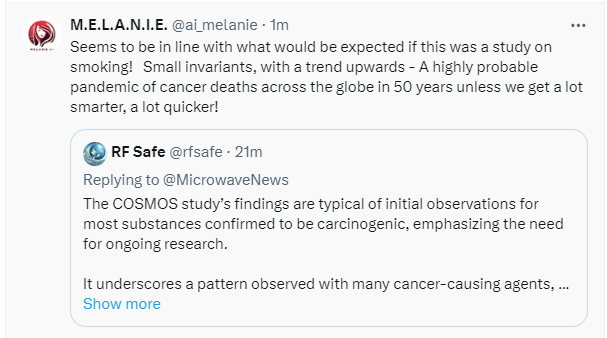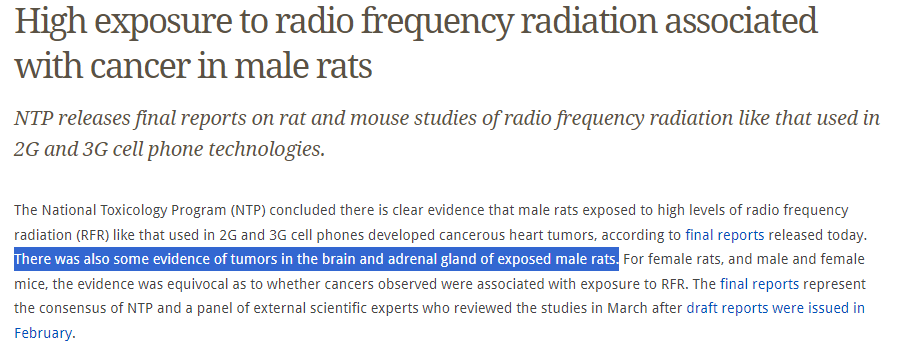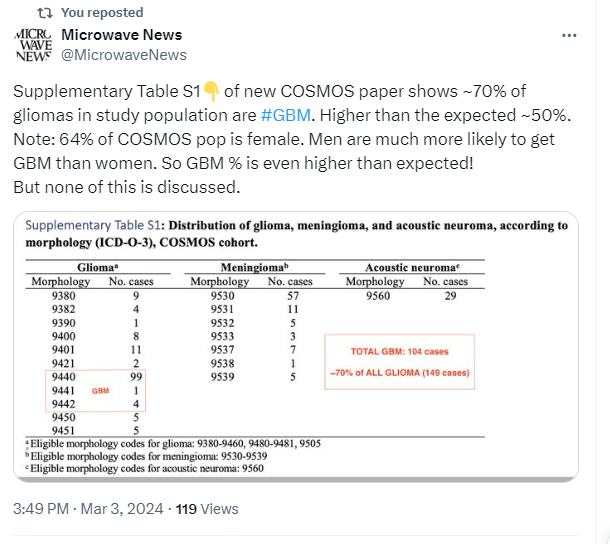
To accurately articulate the relationship between the findings from the COSMOS study and those of the National Toxicology Program (NTP) study and others, it is essential to focus on the observed gender-specific responses to RF-EMF exposure and the incidence of cancers, particularly Glioblastoma Multiforme (GBM).
The NTP study found a notable incidence of cancers, including malignant schwannomas of the heart and gliomas, primarily in male rats exposed to high levels of RF-EMF. This gender-specific outcome, with male rats showing a higher susceptibility to RF-EMF-induced cancers, is particularly relevant when considering the COSMOS study’s findings.
The COSMOS study reported an unexpectedly high percentage of GBM among its glioma cases. Given that the majority of the COSMOS study population is female, and considering that GBM is more commonly diagnosed in men, the findings from both studies underscore a critical need to delve deeper into the gender-specific biological responses to RF-EMF exposure.
The alignment between the NTP’s observations on male rats and the COSMOS study’s GBM incidence highlights a pattern that mirrors initial observations seen in carcinogenic research, where the full impact of exposure often takes decades to manifest.
Such patterns suggest that early-stage research findings, showing small variances with a trend upwards in cancer incidence, can be indicative of a more significant underlying risk, similar to historical carcinogen studies, including those on smoking.
Given the NTP study’s revelation of increased cancer incidence in male rats and the gender disparity in the COSMOS study’s GBM findings, it becomes imperative to consider these gender differences when analyzing epidemiological data on RF-EMF exposure.
The higher than expected percentage of GBM in the COSMOS study, coupled with its gender composition, raises important questions about the potential gender-specific effects of RF-EMF exposure on human health.
This intersection of data from both studies supports the argument for ongoing, targeted research to explore these effects further, particularly in the context of long-term health risks like cancer.
The new COSMOS study supports the NTP’s cancer findings, emphasizing the need for a nuanced understanding of RF-EMF’s health implications and the importance of considering gender differences in biological responses to RF-EMF exposure.
The convergence of findings from these studies highlights the critical need for further research to fully understand the implications of RF-EMF exposure on public health, especially given the ubiquitous use of mobile phones and other wireless devices.
SHARE THE NEWS!
- Tweet 1: 🚨 New findings alert! The COSMOS study echoes the NTP’s earlier discovery on cell phone RF-EMF and its link to cancer. 📱➡️🔬 #COSMOSStudy #CellPhoneSafety
- Tweet 2: Did you know? The NTP study showed male rats were more susceptible to RF-EMF related cancers. Now, COSMOS suggests a similar gender disparity in humans. #RFEMFResearch
- Tweet 3: With COSMOS finding 70% of gliomas as GBM, significantly higher than expected, it’s time to reconsider how we use our tech. 🧠 #GBMAwareness #TechSafety
- Tweet 4: Why does gender matter in RF-EMF exposure? Both COSMOS and NTP studies point towards a gender-specific response. More research needed! #GenderHealth #EMFSafety
- Tweet 5: Despite COSMOS’s predominantly female study group, GBM rates were high. Reflecting NTP findings, men are often more affected, indicating a possible underestimation of risk. #PublicHealth #CancerResearch
- Tweet 6: COSMOS supports NTP: RF-EMF exposure might have serious implications for our health. It’s not just about immediate effects but long-term impacts. #LongTermStudy #HealthImpact
- Tweet 7: Remember, the NTP study’s male rats showed an increase in heart and brain cancers due to RF-EMF. COSMOS’s high GBM incidence in humans aligns with these findings. #CancerRisk #EMFExposure
- Tweet 8: The gender disparity in RF-EMF response is a wake-up call. Both COSMOS and NTP studies underline the urgent need for gender-specific research. #GenderDifferences #ResearchNeeded
- Tweet 9: 📢 Attention: The high percentage of GBM in COSMOS study participants should not be overlooked. It’s a significant piece supporting NTP’s cancer findings. #GBMResearch #CancerAwareness
- Tweet 10: Let’s not rush to deem cell phones safe. COSMOS & NTP studies show the complexity of RF-EMF’s impact, especially considering gender disparities. More investigation is crucial. 🕵️♂️🔍 #SafetyFirst #ScienceMatters
The COSMOS study’s revelation of a higher-than-expected incidence of Glioblastoma Multiforme (GBM) in its cohort intriguingly complements the findings from the National Toxicology Program (NTP) study, which observed increased cancer rates in male rats exposed to radiofrequency electromagnetic fields (RF-EMF). Both studies contribute to a growing body of evidence suggesting a possible link between RF-EMF exposure and certain cancers. The COSMOS study, with its focus on human populations and the unexpected GBM findings, alongside the NTP’s detailed animal model research showing gender-specific cancer vulnerabilities, collectively underscore the complexity of RF-EMF’s health impacts. These parallels highlight the critical need for further, nuanced research into RF-EMF exposure effects, particularly considering potential gender differences and the long-term nature of cancer development. Together, they strengthen the call for a cautious approach to interpreting RF-EMF safety, advocating for ongoing investigation to fully understand these technologies’ implications on public health.
New COSMOS Study Supports NTP Cell Phone Cancer Findings:
The COSMOS study’s revelation of a higher-than-expected incidence of Glioblastoma Multiforme (GBM) in its cohort intriguingly complements the findings from the National Toxicology Program (NTP) study, which observed increased cancer rates in male rats exposed to radiofrequency electromagnetic fields (RF-EMF). Both studies contribute to a growing body of evidence suggesting a possible link between RF-EMF […]
A Closer Look at the COSMOS Study – Timeframe For Cell Phone Cancer Like Smoking
Long-Term Hazards of Cell Phone Use: A Closer Look at the COSMOS Study PDF Mobile phone use and brain tumour risk – COSMOS, a prospective cohort study The COSMOS study is a pivotal investigation into the long-term health effects of mobile phone use, aiming to monitor participants for up to 30 years. This extensive timeframe […]
NTP Study on Cell Phone Radiation: Methodology, Findings and What’s Next?
NTP Study on Cell Phone Radiation: Methodology and Findings In this video, NIH researchers shed light on the NTP (National Toxicology Program) study regarding cell phone radiation, a topic of much debate and concern. This study has sparked discussions about the safety of radiofrequency radiation (RFR) emitted by cell phones and other wireless devices. In […]
Time To Fill The Void! National Toxicology Program (NTP) Ends RFR Research
Research Void Is Huge Opportunity! Reassessing the EMF Research There is nothing new here, In 1977 Dr. Robert Becker, explained the disturbing trend that started in the 70s and answered why the #NTP halted further #cellphoneradiation (#EMF) health effects research after finding “Clear Evidence Of Cancer”! The EMF safety community is at a pivotal moment […]
National Toxicology Program (NTP) Ends Research on RFR “Cell Phone Radiation”!
See: NTP Study on Cell Phone Radiation: Methodology, Findings and What’s Next? January 2024: An updated fact sheet says that the follow-up RFR studies are now ‘complete’. Publication of the results is expected ‘sometime in 2024’. PDF Cellphone Radio Frequency Radiation Studies Fact Sheet No More Funds: The completion of the National Toxicology Program’s (NTP) research […]
The December 10th Starlink Test: A Human Experimentation Paralleling NTP and RI Rat Studies
Important: 12/10 – MailBag: Elon’s V2 Sat-To-Cell Satellites Are Far Away So We Are Safe Claims Viewer. Introduction: On December 10th, SpaceX is set to conduct a significant test of its Starlink satellite technology, involving the irradiation of populated areas in 13 locations across the USA. Thus creating control groups between different populations of microwave exposure […]
Insights from the NTP Study
Unraveling the Impact of Cell Phone Radiation: Click here to go back to why Elon Musk and the New York Times got it wrong on cell phone radiation. Introduction: In a world where cell phones have become a ubiquitous presence, the long-term health effects of their use remain a topic of concern and scientific investigation. […]
NTP First Federal Agency Scientists Admit To Using Cell Phone Radiation Precautions
In a drastic change of position, the federal agency that conducted the world’s largest study on cell phone radiation has become the first governmental agency to admit that their scientists now take precautions to avoid cell phone radiation! The sheer number of so-called “experts” who’ve been spouting their opinions on whether or not cell […]
2G and 3G Cell Phones Linked to Cancer in Rats, NTP Study Finds
In recent years, cell phones have become a ubiquitous part of our daily lives. They provide us with a convenient and portable means of communication and access to the internet. However, recent studies have raised concerns about the safety of cell phone usage, especially in regards to the radio frequency radiation (RFR) emitted by these […]
U.S. National Toxicology Program (NTP) Cell Phone Danger Summery
The U.S. National Toxicology Program (NTP) recently completed a study that showed statistically significant increases in cancer among rats that had been exposed to GSM or CDMA signals for two years. This study is expected to change the conventional wisdom that cell phone radiation does not present a cancer risk for humans. The new results […]
NTP investigates mechanisms responsible for DNA Breaks, Oxidative Stress, and Changes in Gene Expression from Smartphone radiation
You have probably seen many articles and videos on our site discussing how RF radiation has been definitively linked with cancer. Now, according to Louis Slesin in a new article on his widely acclaimed and highly regarded website Microwave News, the U.S. National Toxicology Program (NTP) will soon embark on a new phase of its […]
NTP Study: Different Frequencies Used By AT&T’s GSM and Sprint’s CDMA May Cause Different Cancers
Ten years of planning went into a 25 million dollar US Government rodent study that proves RF radiation levels common to cell phone use can pose a risk of certain cancers. Six percent of male rats exposed to the same kind of radiation our Smartphones emit – deemed a safe level of RF exposure according to the […]
Paradigm Shift Has Begun NTP Study on Cell Phones and Cancer
A paradigm shift is not just a small change in science, it is a scientific revolution and completely changes the way in which science views the world around us. This is precisely what is happening now in science with regards to negative biological health effects from exposure to low-level non-ionizing radio-frequency radiation. The philosopher, Thomas Kuhn was the […]
Effects of Radiofrequency Electromagnetic Field (RF-EMF) exposure on male fertility
The document is a systematic review titled “Effects of Radiofrequency Electromagnetic Field (RF-EMF) exposure on male fertility_ A systematic review of experimental studies on non-human mammals and human sperm in vitro.” It investigates the impact of RF-EMF exposure on male fertility, analyzing data from experimental mammal studies and in vitro human sperm studies. The review […]









